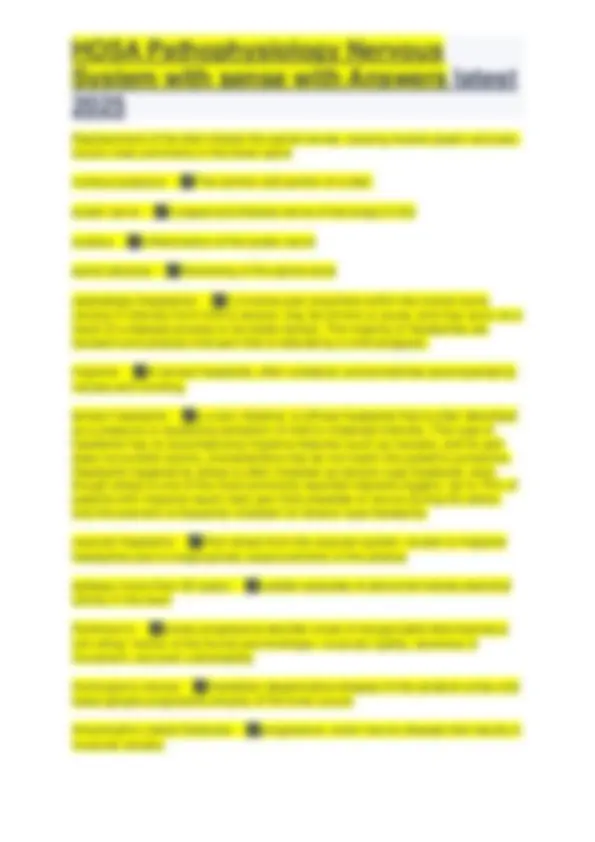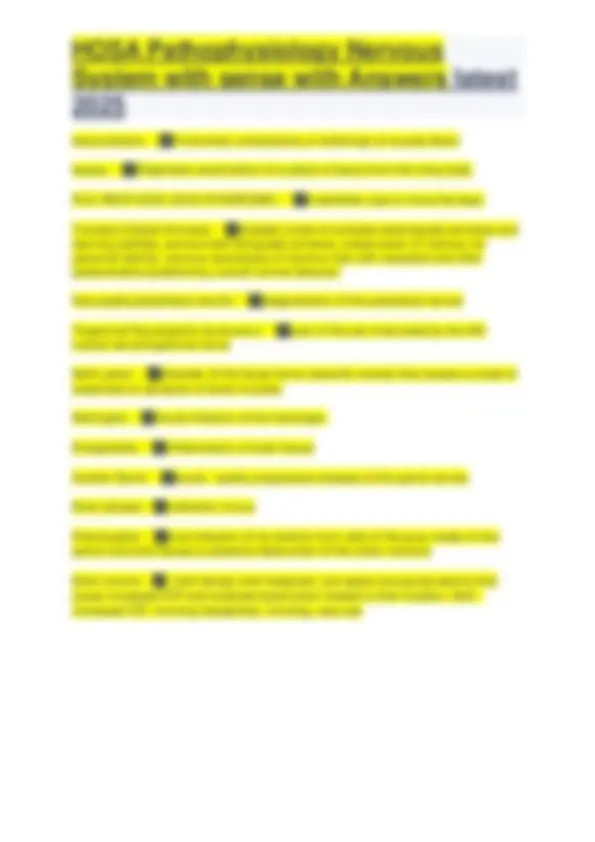




Study with the several resources on Docsity

Earn points by helping other students or get them with a premium plan


Prepare for your exams
Study with the several resources on Docsity

Earn points to download
Earn points by helping other students or get them with a premium plan
Community
Ask the community for help and clear up your study doubts
Discover the best universities in your country according to Docsity users
Free resources
Download our free guides on studying techniques, anxiety management strategies, and thesis advice from Docsity tutors
HOSA Pathophysiology Nervous System with sense with Answers latest 2025.pdf
Typology: Exams
1 / 4

This page cannot be seen from the preview
Don't miss anything!



Cerebrovascular accident (stroke) - ✅brain is damaged by a sudden disruption in the flow of blood to a part of the brain {embolic} or by bleeding inside the head{hemorraghic} aphasia - ✅Disturbance in language comprehension or production, often as a result of a stroke. dysphasia - ✅Difficult speech paralysis - ✅Absence of strength secondary to nervous impairment. hemiparesis - ✅partial paralysis of the right or left half of the body diplopia - ✅Double vision. Transient Ischemic Attack (mini-stroke) - ✅temporary episodes with a duration of less than 24 hours of impaired neurologic functioning caused by an inadequate flow of blood to a portion of the brain ulcer - ✅A deep loss of skin surface that may extend into the dermis; may cause periodic bleeding and the formation of scars. concussion - ✅A loss of function, either partial or complete, as resulting from a blow or fall (for instance) contusion - ✅A bruise contrecoup - ✅also known as a counter blow, is an injury that occurs beneath the skull opposite to the area of impact epidural hematoma - ✅collection of blood that forms between the skull and the dura mater dura mater - ✅Outermost layer of the meninges subdural hematoma - ✅blood collects btween the dura mater and the arachnoid membrane
arachnoid membrane - ✅middle layer of the three membranes (meninges) that surround the brain and spinal cord craniotomy - ✅Incision into the skull cerebral concussion - ✅Temporary brain dysfunction (brief loss of consciousness) after injury, usually clearing within 24 hours cerebral contusion - ✅Bruising of brain tissue as a result of direct trauma to the head; neurologic deficits persist longer than 24 hours Depressed skull fracture - ✅-bone pressed inward into the brain tissue to at least the thickness of the skull; skull depressed : may cause bruising or tearing of dura and lead to menengitis or seizures, - skull depressed : may cause bruising or tearing of dura and lead to menengitis or seizure hemiplegia - ✅paralysis of one side of the body Battle's signs - ✅Bruising behind the ears (over the mastoid process); a very late sign of skull fracture. Raccon eyes - ✅Basal skull fracture nuchal rigidity - ✅neck stiffness paraplegia - ✅Paralysis from the waist down quadripleiga- ✅loss of nerve function at the cervical region resulting in paralysis of the arms, hands, trunk, and legs. degenerative disk - ✅A condition in which an intervertebral disk loses its normal structural integrity as a result of wear and tear, acute or repeated injuries or aging electromyogram - ✅a graphical record of electric currents associated with muscle contractions analgesic - ✅a medicine used to relieve pain NSAIDS - ✅Non-steroidal anti-inflammatory drug herniated disk - ✅:herniation or rupture of the nucleus pulposus (center gelatinous material within an intervertebral disk) between two vertebrae, also called prolapsed disk; a herniated disk places pressure on a spinal root nerve or the spinal cord.
fasciculations - ✅Involuntary contractions or twitchings of muscle fibers biopsy - ✅Diagnostic examination of a piece of tissue from the living body RLS (RESTLESS LEGS SYNDROME) - ✅irresistible urge to move the legs; Transient Global Amnesia - ✅Sudden onset of compete anterograde amnesia and learning abilities, pronounced retrograde amnesia, preservation of memory for personal identity, anxious awareness of memory loss with repeated and often perseverative questioning, overall normal behavior Neuropathy/peripheral neuritis - ✅degeneration of the peripheral nerves Trigeminal Neuralgia/tic douloureux - ✅pain of the are innervated by the fifth cranial nerve/trigeminal nerve Bell's palsy - ✅disorder of the facial nerve (seventh cranial) that causes a onset of weakness or paralysis of facial muscles Meningitis - ✅Acute infection of the meninges. Encephalitis - ✅inflammation of brain tissue Guillain-Barre - ✅acute. rapidly progressive disease of the spinal nerves Brain abcess- ✅collection of pus Poliomyelitis - ✅viral infection of he anterior horn cells of the gray matter of the spinal cord and causes a selective destruction of the motor neurons Brain tumors- ✅, both benign and malignant, are space-occupying lesions that cause increased ICP and localized dysfunction related to their location, S&S - increased ICP, morning headaches, vomiting, seizures